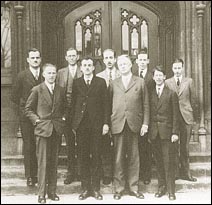![]()
 Heisenberg, standing front left, next to P.A.M. Dirac, in front of A.H. Compton, University of Chicago, 1929. |
Broadcasters David Peat (DP) and Paul Buckley (PB) with Werner Heisenberg
DP Could you reminisce about the time when you arrived at the idea of quantum mechanics? Heisenberg: At that time, there was general discussion among young physicists about the possible ways to establish a coherent quantum theory, a coherent quantum mechanics. Among the many attempts, the most interesting for me was the attempt of H.A. Kramers to study the dispersion of atoms and, by doing so, to get some information about the amplitudes for the radiation of atoms. In this connection, it occurred to me that in the mathematical scheme these amplitudes behaved like the elements of a mathematical quantity called a matrix. So I tried to apply a mathematical calculus to the experiments of Kramers, and the more general mechanical models of the atom, which later turned out to be matrix mechanics. It so happened at that time I became a bit ill and had to spend a holiday on an island to be free from hay fever. It was there, having good time to think over the questions, that I really came to this scheme of quantum mechanics and tried to develop it in a closed mathematical form. My first step was to take it to W. Pauli, a good friend of mine, and to discuss it with him, then to Max Born in Göttingen. Actually, Max Born and Pascual Jordan succeeded in giving a much better shape and more elegant form to the mathematical scheme. From the mathematical relations I had written down, they derived the so-called commutation relations. So, through the work of Born and Jordan, and later Paul Dirac, the whole thing developed very quickly into a closed mathematical scheme. I also went to discuss it with Niels Bohr, but I can't be sure whether this was in July, August, or September of that year [1925]. Half a year later the first papers of E. Schrödinger became known. Schrödinger tried to develop an older idea of Louis de Broglie into a new mathematical scheme, which he called wave mechanics. He was actually able to treat the hydrogen atom on the basis of his wave mechanical scheme and, in the summer of 1926, he was also able to demonstrate that his mathematical scheme and matrix mechanics were actually two equivalent mathematical schemes, that they could be simply translated into each other. After that time, we all felt that this must be the final mathematical form of quantum theory. DP Had you and Bohr begun the interpretation of this work before Schrödinger's paper came out? Heisenberg: Of course, there was continuous discussion, but only after Schrödinger's paper did we have a new basis for discussion, a new basis for interpreting quantum theory. In the beginning there was strong disagreement between Schrödinger and ourselves, not about the mathematical scheme, but about its interpretation in physical terms. Schrödinger thought that by his work physics could again resume a shape which could well be compared with Maxwell's theory or Newton's mechanics, whereas we felt that this was not possible. Through long discussions between Bohr and Schrödinger in the fall of 1926, it became apparent that Schrödinger's hopes could not be fulfilled, that one needed a new interpretation. Finally, from these discussions, we came to the idea of the uncertainty relations, and the rather abstract interpretation of the theory. PB Did Schrödinger ever like that interpretation? Heisenberg: He always disliked it. I would even guess that he was not convinced. He probably thought that the interpretation which Bohr and I had found in Copenhagen was correct in so far as it would always give the correct results in experiments; still he didn't like the language we used in connection with the interpretation. Besides Schrödinger, there were also Einstein, M. von Laue, M. Planck, and others who did not like this kind of interpretation. They felt it was too abstract, and too far removed from the older ideas of physics. But, as you know, this interpretation has, at least so far, stood the test of all experiments, whether people like it or not.
|